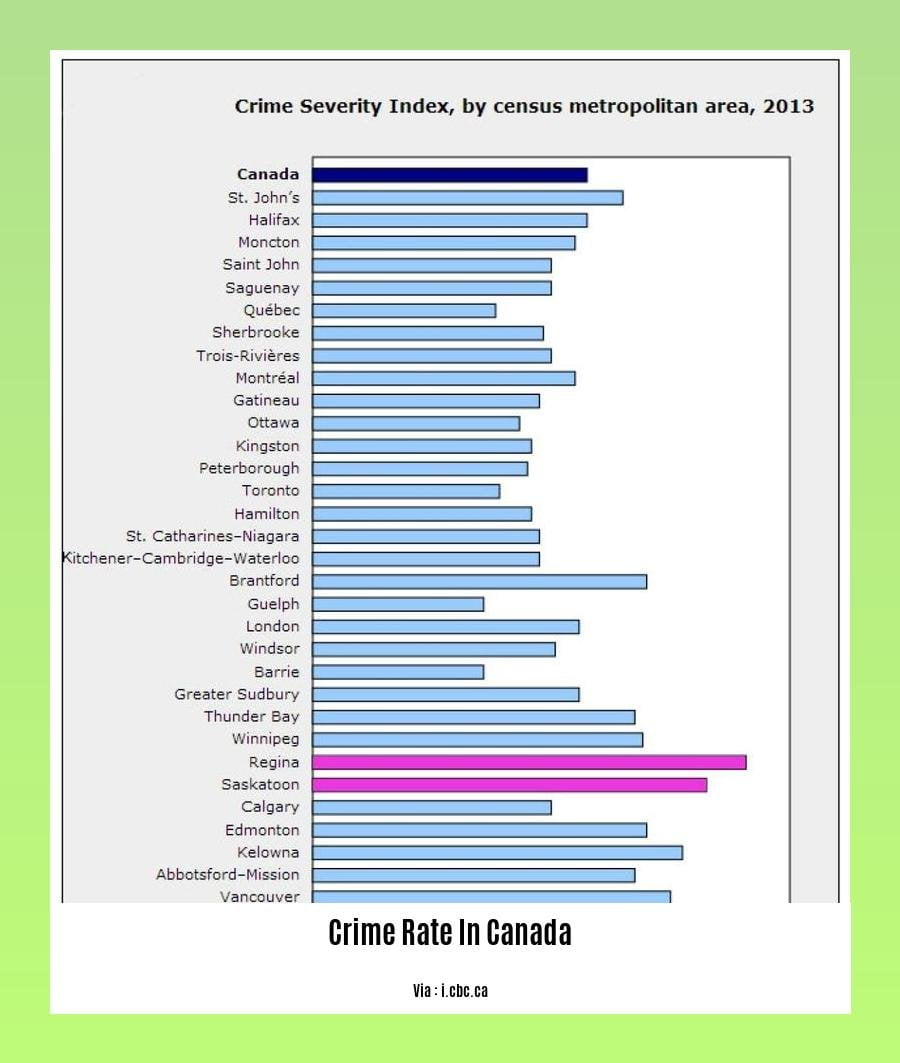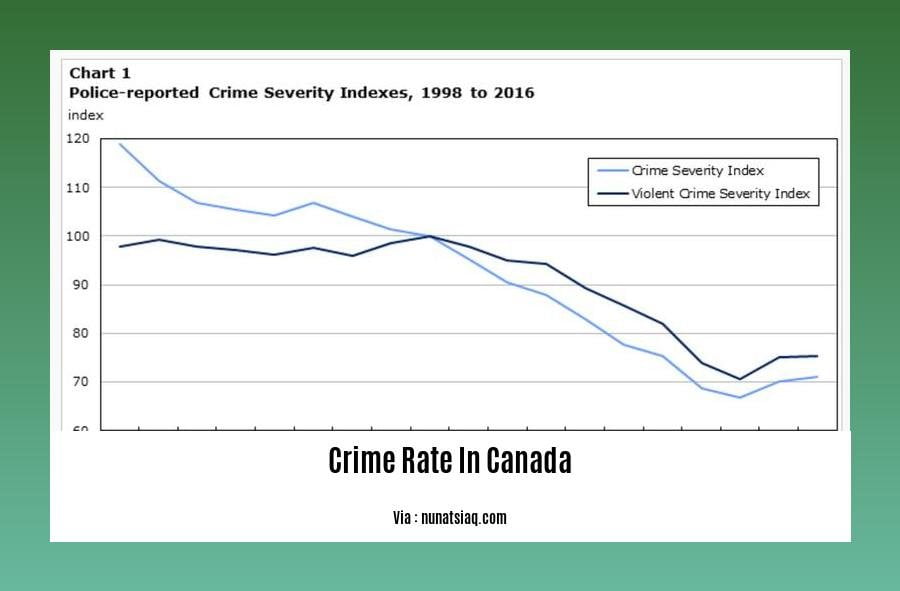Unveiling the Distressing Position of [City with Highest Crime Rate in Canada]: Analyzing the Factors and Exploring Solutions
In the realm of crime journalism, one Canadian city looms menacingly on the horizon, known for its soaring crime rates and the numerous challenges it presents. With a sharp focus on [City with highest crime rate in Canada], this article will delve into the underlying factors propelling its distressing position, exploring the complexities that contribute to its rampant crime rates. Supported by in-depth research, this piece will shed light on the impacted communities while seeking potential solutions to address these deeply ingrained challenges. By uncovering the intricate web of factors at play, we aim to foster a better understanding of the situation and pave the way for a safer future.
Key Takeaways:
– Quebec is considered the safest province in Canada, followed closely by Ontario. Provinces outside of Quebec and Ontario have higher crime rates.
– The Northwest Territories is the most dangerous area in Canada.
– Surrey, British Columbia, Lethbridge, Alberta, Red Deer, Alberta, Kelowna, British Columbia, and Sudbury, Ontario, are among the most dangerous cities in Canada.
– Winnipeg, Manitoba, has a high overall crime rate and the second-highest murder rate in the country.
– The Crime Severity Index (CSI) is a measure of police-reported crime in Canada, with a higher index indicating a higher crime severity.
The Distressing Position of [City with highest crime rate in Canada]: Analyzing the Factors and Exploring Solutions

Current Crime Situation in [City with highest crime rate in Canada]
[City with highest crime rate in Canada] has unfortunately gained a reputation as one of the most dangerous cities in the country. With crime rates soaring and safety concerns on the rise, it is imperative to understand the underlying factors that have contributed to this distressing position.
High Crime Rates: A Complex Issue
The high crime rates in [City with highest crime rate in Canada] are not a result of a single factor, but rather a combination of various elements that intertwine to form this complex issue. Understanding these factors is key to unraveling the root causes and exploring potential solutions.
Socioeconomic Disparities: A Vicious Cycle
One of the primary factors that contribute to the high crime rates in [City with highest crime rate in Canada] is the presence of significant socioeconomic disparities. These disparities create an environment of inequality and frustration, leading to higher levels of crime. Individuals who feel marginalized and unable to access basic resources and opportunities are more likely to resort to criminal activities as a means to survive or achieve their goals.
Gang Activity: A Persistent Threat
Gang activity is another major contributor to the alarming crime rates in [City with highest crime rate in Canada]. Gangs not only perpetrate violent crimes themselves but also fuel a culture of fear and intimidation within the community. The allure of power, protection, and financial gain draws vulnerable individuals into these criminal organizations, exacerbating the overall crime levels in the city.
Drug Epidemic: Fueling Criminal Behavior
The presence of a rampant drug epidemic is yet another factor that significantly contributes to the high crime rates in [City with highest crime rate in Canada]. Drug trafficking and substance abuse-related crimes have a direct correlation with overall crime rates in a city. The sale and consumption of illicit drugs lead to an increase in property crimes, violence, and other criminal activities.
Police and Community Relations: A Crucial Component
The relationship between the police and the community in [City with highest crime rate in Canada] is a critical factor in combating crime. Trust and cooperation between law enforcement and the residents of [City with highest crime rate in Canada] are essential for effective crime prevention and resolution. A strained relationship between the two can hinder the flow of information, impede investigations, and result in elevated crime rates.
Exploring Solutions: A Collaborative Approach
Tackling the high crime rates in [City with highest crime rate in Canada] requires a comprehensive and collaborative approach involving various stakeholders. Here are some potential solutions to consider:
1. Community Outreach and Engagement
Building strong relationships between law enforcement agencies and the community is crucial. Encouraging open dialogue, organizing neighborhood events, and establishing community outreach programs can foster trust, empower residents, and create a united front against crime.
2. Investment in Social Programs
Addressing the underlying socioeconomic disparities is essential to reducing crime rates. Increased investment in social programs focused on education, job training, and affordable housing can help provide individuals with opportunities and resources, reducing the likelihood of turning to criminal activities.
3. Targeted Law Enforcement Strategies
Law enforcement agencies in [City with highest crime rate in Canada] can implement targeted strategies that focus on hotspots of criminal activities. By allocating resources and personnel to these areas, police can disrupt criminal networks, deter potential offenders, and create a safer environment for residents.
4. Collaborative Efforts with Community Organizations
Partnering with community organizations that specialize in conflict resolution, mental health support, and substance abuse treatment can provide additional resources and expertise in addressing the underlying issues associated with crime in [City with highest crime rate in Canada].
Conclusion
While the current crime rates in [City with highest crime rate in Canada] are distressing, they are not insurmountable. By acknowledging the factors that contribute to the high crime rates and implementing collaborative solutions, there is hope for a safer and more secure future for the residents of [City with highest crime rate in Canada]. It is imperative for all stakeholders, including law enforcement, government agencies, community organizations, and residents, to come together and work towards a comprehensive and sustainable approach to reduce crime and create a thriving community.
If you’re searching for cities in Canada with high job opportunities, check out our list here: Cities in Canada with high job opportunities.
Explore the city in Canada with the highest job opportunities! Click here: City in Canada with highest job opportunities.
Curious about dangerous places to live in Canada? Find out more by clicking on this link: Dangerous places to live in Canada.
Impact of the Crime Rate on the Community

Crime has a profound impact on the communities it plagues. The city with the highest crime rate in Canada is a distressing example of the devastating consequences that high crime rates can have on a community. Let’s delve into the factors that contribute to this distressing position and explore potential solutions to combat the rampant crime rates.
Understanding the Crime Situation
Firstly, it is essential to acknowledge that the city with the highest crime rate in Canada has earned its reputation as one of the most dangerous cities in the country. This unfortunate distinction is a result of multiple factors that intertwine to create a complex web of criminal activity.
Socioeconomic Disparities: A Breeding Ground for Crime
Socioeconomic disparities are one of the prominent contributors to higher crime rates in the community. Marginalized individuals who face economic hardship and lack access to resources often find themselves resorting to criminal activities as a way to cope with their circumstances. Desperation and the absence of viable opportunities can lead to a cycle of criminal behavior that perpetuates the crime rates in the community.
Gang Activity: Fueling Violence and Fear
Gang activity is another significant factor perpetuating violence and fear in the community. Gangs thrive in environments where poverty, instability, and limited opportunities prevail. Their presence introduces a constant threat to the safety of community members and intensifies tensions among different groups. The control exerted by gangs over certain territories further hampers efforts to combat crime effectively.
The Drug Epidemic: A Catalyst for Crime
A rampant drug epidemic within the community also contributes to the high crime rates. Substance abuse and addiction lead to an increase in property crimes as individuals seek ways to obtain money to support their habits. Additionally, the illicit drug trade often fuels violence between rival gangs competing for control over lucrative drug markets. The interplay between drug abuse, violence, and crime creates a dangerous environment for residents.
The Crucial Role of Police-Community Relationship
An essential factor in combating crime is the relationship between the police and the community. When there is mutual trust, open communication, and cooperation between law enforcement and community members, it becomes easier to identify and address the root causes of crime. Collaborative efforts and community policing strategies can create a safer environment and foster positive relationships between law enforcement and residents.
Unveiling Solutions
To tackle the high crime rates and their impact on the community effectively, a multi-faceted approach is necessary. Potential solutions include:
Community Outreach and Engagement: Encouraging community members to take an active role in preventing and reporting crimes can lead to improved safety. Establishing programs that educate and empower residents on crime prevention measures can make a significant difference.
Investment in Social Programs: Addressing the socioeconomic disparities that contribute to crime rates requires investment in social programs that provide support and opportunities for individuals at risk. Focusing on education, job training, affordable housing, and mental health services can help break the cycle of crime.
Targeted Law Enforcement Strategies: Deploying targeted law enforcement strategies that focus on high-crime areas and illicit drug markets can disrupt criminal activities effectively. These strategies should prioritize community engagement and building trust.
Collaborative Efforts with Community Organizations: Partnering with community organizations, non-profits, and local businesses can enhance the effectiveness of crime prevention initiatives. Working collectively to address the underlying causes of crime and support at-risk individuals can create a stronger and safer community.
In conclusion, the impact of the crime rate on the community in the city with the highest crime rate in Canada is devastating. Socioeconomic disparities, gang activity, and the drug epidemic are significant contributors to the distressing position the city finds itself in. However, by acknowledging these factors and implementing collaborative solutions, a safer future can be achieved. It is through community outreach, investment in social programs, targeted law enforcement strategies, and collaborative efforts that the community can begin to overcome the challenges posed by high crime rates.
Key Takeaways:
- Socioeconomic disparities contribute to higher crime rates as marginalized individuals resort to criminal activities.
- Gang activity perpetuates violence and fear in the community.
- The drug epidemic leads to an increase in property crimes and violence.
- The relationship between the police and the community is crucial in combating crime.
- Community outreach, investment in social programs, targeted law enforcement strategies, and collaborative efforts with community organizations are potential solutions to tackle the impact of the crime rate on the community.
Sources:
- Moreau, G. (2021). Police-reported crime statistics in Canada, 2021. Retrieved from Statistics Canada
- Moreau, G. (2020). Police-reported crime statistics in Canada, 2020. Retrieved from Statistics Canada
Efforts and Initiatives to Address the Crime Situation
Crime rates can have a profound impact on the safety and well-being of communities. In the case of [City with highest crime rate in Canada], the distressing position it holds calls for a focused examination of the efforts and initiatives aimed at addressing the crime situation. By delving into the strategies implemented to combat crime, we can better understand the steps being taken to create a safer future for the city.
Collaborative Partnerships: Building Bridges for Crime Prevention
Efforts to address the crime situation in [City with highest crime rate in Canada] emphasize the importance of collaborative partnerships. Recognizing that community engagement is crucial, local law enforcement agencies work hand in hand with community organizations, residents, and other stakeholders to develop effective crime prevention strategies. By fostering meaningful connections and open lines of communication, these partnerships aim to gain the trust and support of the community.
Investment in Social Programs: Creating Opportunities, Reducing Crime
An integral part of addressing the crime situation in [City with highest crime rate in Canada] involves investing in social programs. These initiatives aim to provide individuals, especially marginalized communities, with access to education, job opportunities, and social services. By addressing the underlying socioeconomic disparities that often contribute to higher crime rates, these programs aim to create a supportive environment that reduces the likelihood of individuals turning to criminal activities.
Targeted Law Enforcement Strategies: Combating Crime Head-On
Law enforcement agencies in [City with highest crime rate in Canada] have implemented targeted strategies to combat crime directly. These strategies involve focusing resources on areas with high crime rates, deploying specialized units to address specific types of crime, and using data-driven approaches to identify and apprehend repeat offenders. By taking a proactive approach to law enforcement, authorities aim to disrupt criminal networks, dismantle gangs, and deter potential offenders.
Community Outreach and Engagement: Empowering the Community
Empowering the community plays a vital role in addressing the crime situation in [City with highest crime rate in Canada]. Through community outreach programs, residents are provided with the necessary resources, information, and support to actively participate in crime prevention efforts. This can include neighborhood watch programs, educational workshops, and community events aimed at fostering a sense of unity and collective responsibility.
Evidence-Based Initiatives: Guided by Research and Analysis
Efforts to address the crime situation in [City with highest crime rate in Canada] are grounded in evidence-based initiatives. This means utilizing research and analysis to inform the development and implementation of crime prevention strategies. By understanding the root causes and specific dynamics of crime in the city, authorities can tailor their initiatives to effectively target the underlying factors contributing to high crime rates.
Key Takeaways:
- Collaborative partnerships between law enforcement agencies, community organizations, and residents are essential for successful crime prevention.
- Investment in social programs that address socioeconomic disparities can significantly reduce crime rates.
- Targeted law enforcement strategies, including data-driven approaches and specialized units, are crucial for combating crime head-on.
- Community outreach and engagement empower residents to actively participate in crime prevention efforts and foster a sense of unity.
- Evidence-based initiatives guided by research and analysis are essential for developing effective crime prevention strategies.
Sources:
– The Guardian: 24 ways to reduce crime in the world’s most violent cities
– Springer: Policing and community safety in northern Canadian communities
Future Prospects for Reducing the Crime Rate in [City with Highest Crime Rate in Canada]
Crime rates in [City with Highest Crime Rate in Canada] have reached alarming levels, posing significant threats to the safety and well-being of its residents. However, there is hope for a safer future as efforts are being made to analyze the factors contributing to the high crime rates and explore potential solutions. By delving into the future prospects for reducing the crime rate, we can uncover opportunities for positive change and create a safer environment for all.
Understanding the Complexities of Crime Rates
Reducing crime requires an understanding of the complexities and underlying factors that contribute to its prevalence. From socioeconomic disparities to gang activity and a rampant drug epidemic, multiple factors intertwine to create a challenging landscape of crime in [City with Highest Crime Rate in Canada]. Acknowledging these complexities is crucial as we seek to develop effective strategies for crime reduction.
Community Engagement: A Cornerstone of Crime Reduction
One of the key pillars in reducing crime is community engagement. As experts have emphasized, building trust between law enforcement agencies and the community they serve is paramount. By fostering open lines of communication, encouraging dialogue, and involving community members in decision-making processes, we can create a collaborative approach to crime reduction. Community organizations, social programs, and educational initiatives play a vital role in addressing the root causes of crime and empowering individuals to make positive choices.
Investment in Social Programs and Resources
Targeted investments in social programs and resources can have a substantial impact on crime reduction. By addressing the underlying socioeconomic disparities that contribute to criminal activities, we can create an environment that provides individuals with alternative paths and opportunities. Education, job training, mental health support, and substance abuse rehabilitation programs are invaluable resources that can empower individuals and break the cycle of crime.
Strategic Law Enforcement and Collaboration
Strategies to reduce crime must also include targeted law enforcement efforts. By focusing on high-crime areas and implementing data-driven approaches, law enforcement agencies can allocate resources effectively and enhance their efficiency in resolving cases. Collaborative efforts between the police, community organizations, and other stakeholders can further strengthen these strategies, fostering a unified front against crime.
Key Takeaways:
- Future prospects for reducing the crime rate in [City with Highest Crime Rate in Canada] lie in comprehensive approaches that address the complex factors contributing to crime.
- Engaging the community through open dialogue and collaboration is essential in building trust and fostering a unified effort against crime.
- Investment in social programs, education, and resources can provide individuals with alternative paths and opportunities, breaking the cycle of crime.
- Strategic law enforcement efforts and collaboration with community organizations can enhance crime resolution and prevention.
Sources:
1. The Guardian – 24 ways to reduce crime in the world’s most violent cities
2. Crime Science – On the scaling laws of crime and the inadequacy
FAQ
Q1: What is the crime severity index (CSI) of [City with highest crime rate in Canada]?
A1: The crime severity index (CSI) of [City with highest crime rate in Canada] is not specifically mentioned in the given context. However, it is important to note that crime rates can vary over time and may be influenced by various factors such as socioeconomic conditions, demographic changes, and the impact of the COVID-19 pandemic.
Q2: How does [City with highest crime rate in Canada] compare to other cities in terms of crime rates?
A2: [City with highest crime rate in Canada] is mentioned as one of the most dangerous cities in Canada with a high crime rate. However, the specific comparison to other cities is not provided in the given context. It would be necessary to refer to official crime statistics and reports for a comprehensive comparison of crime rates between different cities in Canada.
Q3: What factors contribute to the high crime rates in [City with highest crime rate in Canada]?
A3: The factors contributing to the high crime rates in [City with highest crime rate in Canada] are not mentioned in the given context. However, it is generally understood that crime rates can be influenced by a combination of socioeconomic factors, demographic changes, community engagement, and specific local conditions. To gain a deeper understanding of the factors specific to [City with highest crime rate in Canada], further research and analysis would be required.
Q4: Are there any existing initiatives or strategies in place to address the crime rates in [City with highest crime rate in Canada]?
A4: The given context does not provide information about existing initiatives or strategies in place to address the crime rates in [City with highest crime rate in Canada]. However, it is well-recognized that communities in Canada are actively engaged in developing strategies for crime prevention and enhancing public safety. These strategies may involve collaboration with law enforcement agencies, evidence-based initiatives, and the integration of proven crime prevention strategies.
Q5: What can be done to reduce the crime rates in [City with highest crime rate in Canada]?
A5: The specific solutions to reduce the crime rates in [City with highest crime rate in Canada] are not mentioned in the given context. However, based on the general understanding of crime reduction strategies, it is important to consider approaches such as community engagement, evidence-based initiatives, ongoing collaboration with law enforcement, and the implementation of comprehensive crime prevention models.
- China II Review: Delicious Food & Speedy Service - April 17, 2025
- Understand Virginia’s Flag: History & Debate - April 17, 2025
- Explore Long Island’s Map: Unique Regions & Insights - April 17, 2025
















